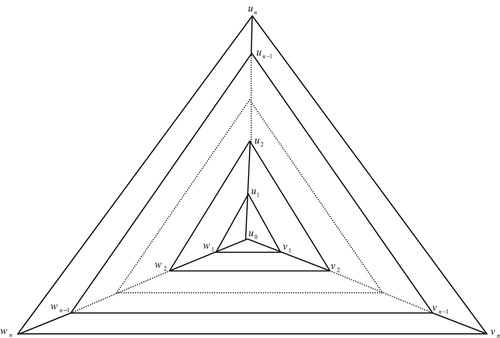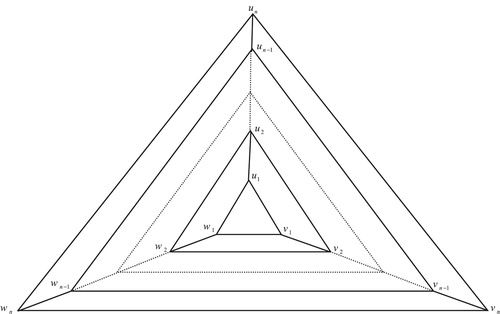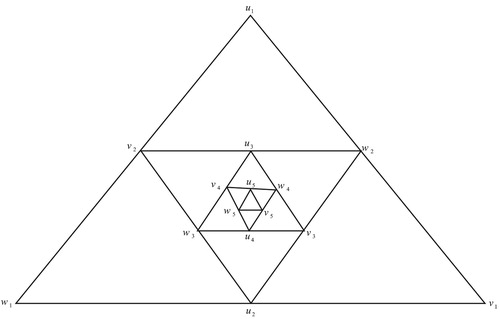 ?Mathematical formulae have been encoded as MathML and are displayed in this HTML version using MathJax in order to improve their display. Uncheck the box to turn MathJax off. This feature requires Javascript. Click on a formula to zoom.
?Mathematical formulae have been encoded as MathML and are displayed in this HTML version using MathJax in order to improve their display. Uncheck the box to turn MathJax off. This feature requires Javascript. Click on a formula to zoom.ABSTRACT
In mathematics, one always tries to get new structures from given ones. This also applies to the realm of graphs, where one can generate many new graphs from a given set of graphs. In this paper, we derive simple formulas of spanning trees of some families of graphs generated by triangle using linear algebra and the knowledge of difference equations. Finally, we compare the entropy of our graphs with other studied graphs with the average degree being 4 and 6.
1. Introduction
The problem of calculating the number of spanning trees on the graph is an important, well-studied problem in graph theory. Deriving formulas for different types of graphs can be proved to be helpful in identifying those graphs that contain the maximum number of spanning trees. Such an investigation has practical consequences related to the network. Thus for both theoretical and practical purpose, we interested to deriving formulas for the number of spanning trees of a graph based on its time complexity in order to calculate the formula. Many cases have been examined depending on the choice of
. It has been studied when
is labelled molecular graph [Citation1], when
is a circulant graph [Citation2], when
is a complete multipartite graph [Citation3], when
is a cubic cycle and quadruple cycle graph [Citation4], when
is a threshold graph [Citation5] and so on. A spanning tree of
is a minimal connected subgraph of
that has the same vertex set as
. The number of spanning trees in
, also called, the complexity of the graph, denoted by
. A classical result of Kirchhoff [Citation6] can be used to determine the number of spanning trees for
. Let
, then the Kirchhoff matrix
defined as
characteristic matrix
, where
is the diagonal matrix of the degrees of
and
is the adjacency matrix of
,
defined as follows: (i)
and
are adjacent and
, (ii)
equals the degree of vertex
if
, and (iii)
otherwise. All of cofactors of
are equal to
.
There are other methods for calculating . Let
denote the eignvalues of
matrix of a
point graph. Then, it is easily shown that
. Furthermore, Kelmans and Chelnokov [Citation7] shown that
. The formula for the number of spanning trees in a
-regular graph
can be expressed as
, where
are the eigenvalues of the corresponding adjacency matrix of the graph. However, for a few special families of graphs, there exist simple formulas that make it much easier to calculate and determine the number of corresponding spanning trees, especially when these numbers are very large.
One of the first such results is due to Cayley [Citation8] showed that complete graph on vertices,
, has
spanning trees. Another result, the complete bipartite graph
with bipartite sets containing
and
vertices has
spanning trees [Citation9,Citation10]. Another result is due to Sedlacek [Citation11] derived a formula for the wheel with
vertices,
, has
spanning trees. Sedlacek [Citation12] also later derived a formula for the number of spanning trees in a Mobius ladder with
vertices,
, has
spanning trees.
Another class of graphs for which an explicit formula has been derived is based on a prism [Citation13,Citation14].
Many works have conceived techniques to derive the number of spanning tree of a graph, which can be found at [Citation15–23].
Now we introduce following Lemma which describes a way to calculate the number of spanning trees by an extension of Kirchhoff formula.
Lemma 1.1
[Citation24]
Let be a graph with
vertices. Then
where
are the adjacency and degree matrices of
, the complement of
, respectively, and
is the
unit matrix.
The advantage of this formula in Lemma1.1 is to express directly as a determinant rather than in terms of cofactors as in Kirchhoff theorem or eigenvalues as in Kelmans and Chelnokov formula.
2. Main results
In mathematics, one always tries to get new structures from given ones. This also applies to the realm of graphs, where one can generate many new graphs from a given set of graphs. In this section, we derive simple formulas of the complexity, number of spanning trees, of four families of graphs generated by a triangle say and
.
Consider the family of graphs generated by triangle and constructed as shown in Figure .
According to the construction, the number of total vertices and edges
are
and
.
It is clear that the average degree of is in the large
limit is
.
Theorem 2.1:
For , the number of spanning trees of the graph
is given by
Proof: The Kirchhoff matrix associated to the graph
is
Thus, we get:
Then we have
Straightforward induction using properties of determinants, we have
, and by expanding the first five determinants of the matrix
, yields
has the values
for
These values can be written in the form:
Thus we have the following recurrence relation
(1)
(1) Its characteristic Equation is
with two roots being
and
.
The general solution of the recurrence relation (1) is
Using the initial condition
and
at
, respectively. We have
Solving these equations, we get
and
, therefore
Thus
Consider the family of graphs
generated by a triangle and constructed as shown in Figure .
According to the construction, the number of total vertices and edges
are
and
.
It is clear that the average degree of is in the large
limit is
.
Theorem 2.2:
For , the number of spanning trees of the graph
is given by
Proof: Applying Lemma 1.1, we have:
Thus, we get:
Straightforward induction using properties of determinants, we have
, and by expanding the first six determinants, yields
has the values
for
These values can be written in the form:
Thus we have the following recurrence relation
(2)
(2) Its characteristic Equation is
with two roots being
and
.
The general solution of the recurrence relation (2) is
Using the initial condition
and
at
, respectively. We have
Solving these equations, we get
and
, therefore
Thus
Consider the family of graphs
generated by the triangle and constructed as shown in Figure .
According to the construction, the number of total vertices and edges
are
and
.
It is clear that the average degree of is in the large
limit is
.
Theorem 2.3: For , the number of spanning trees of the graph
is given by
Proof: Applying Lemma 1.1, we have:
Thus, we get:
Straightforward induction using properties of determinants, we have
, and by expanding the first five determinants, yields
has the values
for
These values can be written in the form:
Thus we have the following recurrence relation
(3)
(3) Its characteristic Equation is
with two roots being
and
.
The general solution of the recurrence relation (3) is
Using the initial condition
and
at
, respectively. We have
Solving these equations, we get
and
, therefore
Thus
Consider the family of graphs
generated by triangle and constructed as shown in Figure .
According to the construction, the number of total vertices and edges
are
and
.
It is clear that the average degree of is in the large
limit is
.
Theorem 2.4:
For , the number of spanning trees of the graph
is given by
Proof: Applying Lemma 1.1, we have:
Thus, we get:
Straightforward induction using properties of determinants, we have
, and by expanding the first six determinants, yields
has the values
for
These values can be written in the form:
Thus we have the following recurrence relation
(4)
(4) Its characteristic Equation is
with two roots being
and
.
The general solution of the recurrence relation (4) is
Using the initial condition
and
at
respectively. We have
Solving these equations, we get
and
, therefore
Thus
3. Numerical results
The following table illustrates some of the values of the number of spanning trees in the graphs and
(Table ).
Table 1. Some values of 
 and
and 
 .
.
It is clear from the table that the number of the graph of average degree
is larger than the other three graphs
of average degree
at different values of
In addition, the number of spanning trees of the graph is larger than the number of spanning trees of the graphs
and
of the same average degree
at different values of
4. Spanning tree entropy
The spanning tree entropy is a quantitative measure of the robustness of a network based on its complexity.
After having explicit Formulas for the number of spanning trees of the sequence of the four graphs and
, we can calculate its spanning tree entropy
which is a finite number and a very interesting quantity characterizing the network structure, defined as in [Citation4,Citation12] as: For a graph
,
(5)
(5)
Now we compare the value of entropy in our graphs with other graphs. It is clear that the entropy of the graph of average degree
is larger than the entropy of the other three graphs
of average degree
. In addition, the entropy of the graph
is larger than the entropy of the two graphs
and
of the same average degree 4. Also the entropy of the graph
is larger than the entropy of the Apollonian graph [Citation25] which has the entropy
of the same average degree 6. Finally, the entropy of our first three graphs
is larger than the entropy of fractal scale-free lattice [Citation26] which has the entropy
5. Conclusions
The number of spanning trees in graphs (networks) is an important invariant. The evaluation of this number is not only interesting from a mathematical (computational) perspective, but also, it is an important measure of reliability of a network and designing electrical circuits. Some computationally hard problems such as the travelling salesman problem can be solved approximately by using spanning trees. In this work, we compute the number of spanning trees of some families of graphs generated by triangle using linear algebra and knowledge of difference equations.
Acknowledgments
The author is grateful to the anonymous reviewers for their helpful comments and suggestions toward improving the original version of the paper.
Disclosure statement
No potential conflict of interest was reported by the author.
ORCID
S. N. Daoud http://orcid.org/0000-0003-3809-2521
References
- Brown TJ, Mallion RB, Pollack P, et al. Some methods for counting the spanning trees in labeled molecular graphs, examined in relation to certain fullerenes. Discrete Appl. Math. 1996;67:51–66. doi: 10.1016/0166-218X(96)85158-4
- Zang Y, Yong X, Golin MJ. The number of spanning trees in circulant graphs. Discrete Math. 2000;223:337–350. doi: 10.1016/S0012-365X(99)00414-8
- Yan WM, Myrnold W, Chung KL. A fromula for the number of spanning trees for a multi-star related graph. Inform. Process. Lett. 1998;68:295–298. doi: 10.1016/S0020-0190(98)00175-6
- Xue-rong Yang T. Acenjian, the number of spanning trees of the cubic cycle and the quadruple cycle. Discrete Math. 1997;169:293–298. doi: 10.1016/S0012-365X(96)00092-1
- Hammer PL, Kelmans AK. Laplacian spectra and spanning trees of threshold graphs. Discrete Appl Math. 1996;65:255–273. doi: 10.1016/0166-218X(94)00049-J
- Kirchhoff GG. Uber die Auflosung der Gleichungen, auf welche man be ider Untersuchung der Linearen Verteilung galvanischer Storme gefuhrt wird. Ann Phys Chem. 1847;72:497–508. doi: 10.1002/andp.18471481202
- Kelmans AK, Chelnokov VM. A certain polynomials of a graph and graphs with an extermal number of trees. J Comb Theory (B). 1974;16:197–214. doi: 10.1016/0095-8956(74)90065-3
- Cayley GA. A theorem on trees. Quart J Math. 1889;23:276–378.
- Clark L. On the enumeration of multipartite spanning trees of the complete graph. Bull ICA. 2003;38:50–60.
- Qiao NS, Chen B. The number of spanning trees and chains of graphs. J Appl Math. 2007;9:10–16.
- Sedlacek J. Lucas number in graph theory. In: Mathematics (geometry and graph theory) (Chech). Prague: Univ. Karlova; 1970. p. 111–115.
- Sedlacek J. On the Skeleton of a graph or digraph. In: R. Guy, M. Hanani, N. Saver, et al., editors. Combinatorial structures and their applications. New York (NY): Gordon and Breach; 1970, p. 387–391.
- Boeschand FT, Prodinger H. Spanning tree formulas and Chebyshev polynomials. J. Graphs Comb. 1986;2:191–200. doi: 10.1007/BF01788093
- Boesch FT, Bogdanowicz ZR. The number of spanning trees in a prism. Inter J Comput Math. 1987;21:229–243. doi: 10.1080/00207168708803568
- Daoud SN. Chebyshev polynomials and spanning tree formulas. Int J Math Comb. 2012;4:68–79.
- Daoud SN. Complexity of some families of cycle related graphs. J Taibah Univ Sci. 2017;11:205–228. doi: 10.1016/j.jtusci.2016.04.002
- Daoud SN. Complexity of graphs generated by wheel graph and their asymptotic limits. J Egypt Math Soc. 2017;25(4):424–433. doi: 10.1016/j.joems.2017.07.005
- Daoud SN. Generating formulas of the number of spanning trees of some special graphs. Eur Phys J Plus. 2014;129:1–14. doi: 10.1140/epjp/i2014-14146-7
- Daoud SN. Number of spanning trees of different products of complete and complete bipartite graphs. Math Probl Eng. 2014:23. Hindawi Publishing Corporation, Article ID 965105.
- Daoud SN. Number of spanning trees in different product of complete and complete tripartite graphs. Ars Comb. 2018;139:85–103.
- Daoud SN. On a class of some pyramid graphs and Chebyshev polynomials. J Math Probl Eng. 2013;2013:11. Hindawi Publishing Corporation, Article ID 820549.
- Daoud SN. The deletion-contraction method for counting the number of spanning trees of graphs. Eur Phys J Plus. 2015;130:1–15. doi: 10.1140/epjp/i2015-15217-y
- Daoud SN. Number of spanning trees in the sequence of some nonahedral graphs. Utilitas Mathematica, Winnipeg.
- Liu J-B, Daoud SN. Complexity of some of pyramid graphs created from a gear graph. Symmetry (Basel). 2018;10:689, doi:10.3390/sym10120689.
- Zhang J, Sun W, Xu G. Enumeration of spanning trees on Apollonian networks. J Stat Mech. 2013;9:P09015. doi: 10.1088/1742-5468/2013/09/P09015
- Zhang Z, Liu H, Wu B, et al. Spanning trees in a fractal scale –free lattice. Phys Rev E. 2011;83:016116. doi: 10.1103/PhysRevE.83.016116




